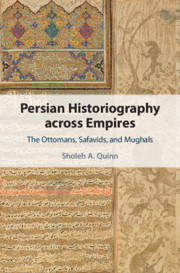
- Cited by 3
-
Cited byCrossref Citations
This Book has been cited by the following publications. This list is generated based on data provided by Crossref.
Bashir, Shahzad 2022. The Wiley Blackwell Companion to Islamic Spirituality. p. 74.
Leong, Amanda Caterina 2024. “I'd rather be married to someone I can control”: Female Javānmardī in Gulbadan Begum's Humayunnamah as a Mirror for Princesses. Iranian Studies, Vol. 57, Issue. 4, p. 510.
Saeedi, Nilab 2024. Similar Narration of the Other: Lârî’s Narration of the Battle of Çaldıran under Ottoman’s Influence (1514). Korkut Ata Türkiyat Araştırmaları Dergisi, p. 1060.
- Publisher:
- Cambridge University Press
- Online publication date:
- November 2020
- Print publication year:
- 2020
- Online ISBN:
- 9781108906975


